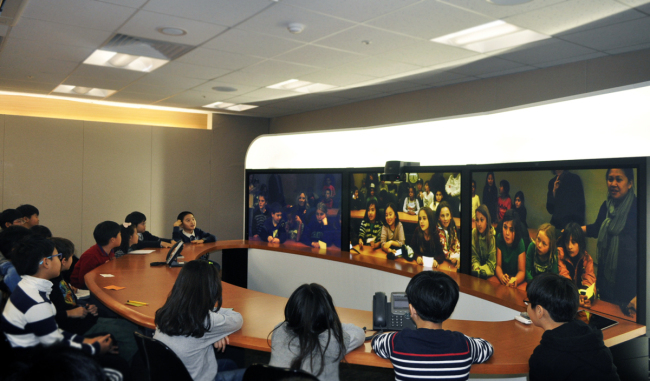A group of fifth graders fiddle with their smartphones in the classroom. Instead of telling them to put them away, the teacher approaches with her own smartphone and shares some Internet resources.
In another elementary school in Gyeonggi Province, a group of mentally challenged children curiously approach a robot named Engkey, programmed to teach English. As the top part of the robot flips open, a woman’s face appears on the screen and the children are instantly curious about what the “robot teacher” has to say.
These are some examples of so-called “smart education,” the integration of education and electronic devices and information technology, that is taking place in Korea.
For years, the Korean government has been seeking to channel Koreans’ tech-savvy nature into education by implementing a smart education system for all elementary, middle and high schools.
Sejong City Office of Education said Monday that it had finished a citywide inspection to ensure that all its schools’ smart education systems were up and running. Education offices in Daegu and Seoul followed suit, with the former expanding the number of model schools for smart education this year from four to six, and the latter commencing on a similar project.
Although the Education Ministry recently announced that it was reassessing the smart education plan due to concerns about a lack of digital educational content, educators across the country are pursing measures to use technology to change the face of education.
 |
|
Students at Chadwick International debate with students at Chadwick School in California via a telepresence room. (Chadwick International) |
One of the biggest advantages of smart education is the instant accessibility of a vast range of information, which can be particularly significant in language education.
“It’s still difficult to get a lot of English language materials. But (on the Internet) we have access to English newspapers from all over the world at our fingertips,” said Shelly Luke-Wille, the elementary school principal at Chadwick International.
She said access to the Internet also means communication channels to native speakers, which opens up “a rich language opportunity” to approach these speakers and broaden relationships.
Hector Ramirez, a senior education advisor at the educational publishing firm Houghton Mifflin Harcourt, said exposure is key when learning a new language.
“As smartphones and tablet computers become more and more prevalent, there are more opportunities than ever to learn and to practice skills. Making the most out of every opportunity to speak and communicate is very important,” he said.
Exposure to native speakers and accessibility to the Internet have both been part of enhancing the quality of education. But some have even tapped into children’s interest in robots to enhance English education.
In 2010, the Daegu city government kicked off a pilot project to use 29 Engkey robots to teach English to youngsters at 21 schools across the city. The 1-meter-tall robot has an LED panel that displays an avatar face of a teacher and is remotely controlled by instructors.
“On average, students gave between 4.2 and 4.5 points (out of 5) for their interest toward the robot teacher, indicating a very high interest,” a Korea Institute of Science and Technology report on the project said. It also showed that students understood most of the content, generally scoring between 3 and 5.
Overall, smart education has been proven to boost students’ interest in subjects by allowing them to partake in lessons through research, debate and other methods that are made easier by smart devices.
But there have been concerns that access to a nearly unlimited supply of information may be a double-edged sword.
“An excessive reliance on cutting-edge technology may deteriorate students’ ability to proactively take part in the learning process,” said Han Kyu-jung, a professor of computer education at Gongju National University of Education,
By tapping on a keyboard, students are able to instantly find answers to their questions. This is demonstrated by the slang word “googling,” meaning the use of the search engine Google to find information on a certain topic.
The information, however, often lacks depth and knowledge of the related field, raising the risk that students will absorb superficial data instead of developing critical thinking skills.
“The easily gained information in the digital age is not really yours; it just stays inside you for a little while and passes on. Smart education must require students to think for themselves,” Han said. “Rather than using smart devices to lecture, a good teacher would lead his or her students to analyze what they’ve learned, debate, digest the information and share it with others.”
Despite the potential dangers, which also include risk of addiction to the Internet and smartphones, experts agree that smart education has huge potential.
When implementing the smart education system, teachers should be careful not to just replace books and notes with digital devices and think that is enough, Chadwick’s Luke-Wille said.
“What we say to teachers is, ‘Don’t use the technology unless it really enhances the (learning) experience,’” she said. “Technology allows the learning to be much more student-centered. I think that’s a huge part of the way the technology is able to change the dynamic in the classroom.”
By Yoon Min-sik (
minsikyoon@heraldcorp.com)